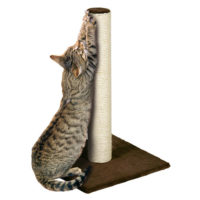How to Handle Cat Scratching

The next in our series of posts from Certified Professional Dog Trainer and owner of Paws in Training Angel Wasserman is all about cat scratching. This is the last post on cat behavior. Later this month, we’ll feature the first in a series from Angel concerning dog behavior and issues dog owners may encounter.
Scratching is a normal cat behavior, and it is fruitless to attempt to stop your cat from scratching. If your cat is scratching inappropriate objects, teach him which specific objects he is allowed to scratch.
The following article will assist you in this process.
Find the right substrate
Cats typically have substrate preferences and once a preference has been established, the cat will consistently seek out surfaces that match his preference.
- Look around your home and make a list of all the objects that your cat is scratching and note the surface types of each. Is everything the cat scratched made of wood? Perhaps softer textiles such as bedding, carpet, upholstered furniture, or drapes appeal to him more.
- While you are making your list, be sure to note the position of the substrate. Is it vertical, flat, slanted or elevated? The position of the substrate is just as important to understand.
Provide the right scratching post
Once you have identified your cat’s substrate preference, provide several scratching posts made from his choice material and those that accommodate his substrate position.
- If your cat has a carpet or textile preference, traditional scratching posts can be covered with these materials.
- If your cat has a wood preference, lumberyards sell a variety of posts and beams that are perfect for cat scratching posts. Small wood logs can easily be mounted to a wooden board and will provide years of scratching enjoyment.
- If your cat has a preference for shiny substrates, small ceramic tiles can be glued to ready made wooden posts, and adding a few metal or shiny tiles will fill your cat’s heart with joy.
- If your cat’s preference is unknown, provide several different types of substrates such as cardboard, carpet, upholstery, wood or sisal and be sure to offer horizontal, vertical and slanted posts.
Once you determine your cat’s preference, you can add additional posts in his preferred texture and position. Also consider providing two different grains on the scratching surfaces. Vertical grains are best to allow the cat to practice raking behaviors while horizontal grains are best for picking.
Scratching posts need to be sturdy enough to remain upright when the cat grabs or scratches it. Posts that fall over or collapse are not likely to be used and may frighten your cat, preventing him from trying a scratching post again.
Scratching post height matters! Cats are natural climbers and typically, taller posts are used with more frequency. If your cat is scratching at your curtains, consider installing a cat shelf on the wall with a carpet or other scratching mat 2-3 feet above the shelf. For box or post scratchers, they should be tall enough to enable your cat to stand on his rear legs and stretch out fully in the vertical position while scratching.
Teach your cat to use scratching posts
Make the new scratching areas interesting to your cat by hanging interactive toys on them, placing treats on top or rubbing them with catnip. Praise your cat profusely while he is investigating the scratcher and when you see him scratch at the post. Be sure to place the posts in areas that the cat is most likely to use!
Manage the environment
Manage the environment to protect objects that you do not want your cat scratching anymore. Simple ways to do this include:
- Remove coveted objects from the room or restrict your cat’s access to a room. If you have an open floor plan, a bi-level cat cage is an excellent way to limit your pet’s movements when you are not home. These cages accommodate your cat’s need to climb, offer plenty of space and can be filled with interactive toys and nesting platforms.
- Place a vinyl carpet runner (hard, knobby side up) on your furniture in the places where the cat would stand to do his scratching.
- Turn stereo speakers toward the wall or use a hard plastic covering for them. Corner wall mount speakers are an ideal alternative to box type, floor speakers.
- If your cat is damaging electronics, such as computers and flat screen TV’s, he is likely demonstrating a preference for warmth and shiny materials. The best course of action is to prevent access to the room where the electronics are present.
- Place the new scratching posts next to the objects the cat used to scratch. This provides an alternative for the cat. As your cat begins using the posts regularly, you can slowly move the posts away from the old objects, eventually moving them to your desired location.
Deter scratching behavior
Provide alternate activities for your cat
Cats who are bored are more likely to scratch inappropriately. Interactive toys that light up, move or make sound are excellent stimulators.
Food and treat balls are also wonderful boredom busters.
Providing a host of elevated surfaces on which to climb and perch can also deter excessive scratching.
Numerous cat shelves, hammocks and other products are available in a variety of aesthetically pleasing options. Refer to the resource section of this article for details.
Many cats enjoy playing in agility equipment such as tunnels or boxes in which they can jump from box to box. Creating a cat playground is economical and will provide hours of entertainment for your cat, ensuring that he’s too busy to scratch inappropriately.
Manage Nail Length
Your cat’s nails should be trimmed on a regular basis. If your cat finds this practice aversive, you may want to consider the use of Soft Claws® which are temporary plastic caps that encase your cat’s claws. This product typically lasts for 6-8 weeks and can be applied at most grooming or veterinary offices. The caps protect your furniture and hard wood floors from being damaged but do not prevent the cat from scratching.
Resources
Cat shelving options in a variety of designer styles, materials and colors
Interactive Toys & Feeders:
- Froli-cat Twitch Interactive Cat Teaser
- Deli-Dome timed treat and food dispenser
- Catit Treat Ball, Ball of the Wild
- Play-N-Squeak Pet Ball made by Our Pets.
Good luck!
Angel Wasserman, CCBC, CPDT
Certified Behavior Consultant-Canine
Paws in Training, Inc.
(919) 896-2859
angel@pawsintraining.com
www.pawsintraining.com
This article was reposted from the Paws in Training website. Find Paws in Training on Facebook, Google+ and Yelp. Check out Woof It Up! A Guide To Happy Dogs and Happy Owners, available in paperback or E-Book formats.

